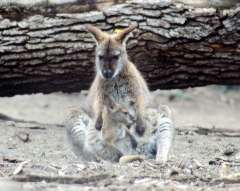Kangaroos
Australia’s Kangaroos are native to the Australian continent and to parts of Papua New Guinea. There are over 60 different species of kangaroo most of them in Australia.
There are no accurate figures for population numbers of kangaroos, but the current number is the highest ever recorded. Four of the 48 species can now be commercially harvested and their numbers are estimated to be 50 - 60 million.
All kangaroos belong to the super-family Macropodidae (or macropods, meaning ‘great-footed').
The different kangaroo species live in diverse habitats from cold-climate rainforests to desert plains to tropical areas.
Kangaroos are herbivorous and eat a range of plants and some fungi.
Most are nocturnal but some are active in early morning and late afternoon.
All kangaroos of all sizes have one thing in common, powerful back legs with long feet.
The kangaroo’s tail is used to balance while hopping and to steady itself when moving slowly.
In the breeding season, usually spring and early summer, rival male kangaroos rear up on their hind legs and box to compete for a female.
The baby kangaroo, or ‘joey’, is born after a gestation of 29 – 38 days.
The joey measures only 2.5cm in length and weighs less than 1g when it is born. It manages to drag itself up to the pouch, were it lives for the next 300 days drinking milk.
After 15 weeks the joey has grown considerable bigger but continue to stay in the pouch for another 6 months.
Most kangaroos have no set breeding cycle and are able to breed all year round.
A kangaroo population can increase fourfold in five years if it has plentiful supplies of food and water.

Aborigines have hunted the kangaroo for tens of thousands of years, for their meat and skins.
All Australian States and Territories have legislation to protect kangaroos.
European farming methods have dramatically increased the number of kangaroos leading to excessive grazing pressure on the vulnerable Australian environment. Kangaroo population management is vital for the protection of some habitats and the survival of other native animals.
Kangaroos are culled by licensed hunters.
The Wildlife Protection (Regulation of Exports and Imports) Act 1982, which had prevented the export of live kangaroos was repealed in 2001.
Read More: Freshwater Crocodiles
